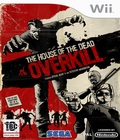Genre: Shooter
Publisher: Sega
Developer: Headstrong Games
Release Date: February 10, 2008
When the original House of the Dead debuted in arcades more than a decade ago, it established a franchise that, along with Virtua Cop and Time Crisis, helped set the standard for light gun shooters for years to come. Offering multiple paths, challenging boss battles and (sometimes unintentional) humor, the games looked good and played well. Last year's House of the Dead 2 & 3 Return brought home two of the arcade games to the Wii in a single package. Although the ports were basic, they stood out in one important aspect — the games included a calibration setting that made using the Wiimote feel a whole lot like using an actual light gun.
For House of the Dead: Overkill, Sega took a different approach. Rather than do a basic port of an arcade game, it partnered with a developer new to the series and developed the first House of the Dead game designed exclusively for the home market. It was a risk, but after playing through the game, it's one that has paid off admirably. With Overkill, Headstrong Games merged the classic shooting action of the franchise with a heavy helping of grindhouse pulp to produce a prequel that is canon in terms of story, but a complete reboot in terms of style.
Speaking of style, when we say that Overkill embraces grindhouse, we mean it. This is a game that starts out balls-to-the-wall, over-the-top and just keeps going from there. Blood sprays with gusto, the f-bombs fly as often as your bullets and some of the monsters are truly grotesque in a depraved sort of way. When you see the "M" rating on the box, the ESRB really means it this time. This isn't exactly a game that middle-America soccer moms are going to want to bring home for little Johnny.
If you're the type who doesn't mind a liberal amount of cussing with your games, however, then you'll want to dive right in because the verbal vitriol is only one small part of the overall package. In keeping with the '70s style, our two heroes, Detective Isaac Washington and Agent G, have a love-hate relationship that plays out over the course of the game, which is presented as seven short "movies." Though the dialogue does occasionally tread from over-the-top amusing to over-the-top repetitive, for the most part it's well-written and well-acted. The cinema scenes work well, and the in-game one liners sound like something you'd expect to hear in a low-budget buddy cop flick.
Supporting characters are similarly developed, with both the leading lady Varla Guns and your nemesis, Papa Caesar having plenty of dialogue. Like many grindhouse films, Varla's name is the definition of double entendre. After all, our heroine is sporting a pair of extra large guns, and she's not shy about showing them off. There are sure to be a number of preteen boys out there spending some quality time with their Wii consoles because of her. It's digital exploitation at its finest.
Visually, Overkill makes great use of the Wii hardware, pumping out a world that is as vibrant as it is disgusting. Levels are nicely detailed, enemies can be dismembered with precision shooting and there are a variety of zombies in the mix. Individual levels see a bit of repetition, but as you move from level to level, different sets of the undead attack en masse. Keeping with the film theme, the screen has a near-constant layer of scratching and the action will occasionally slow down or speed up as if the projector is having a problem. The whole virtual film premise is used to great effect near the end of the game.
With that said, the game isn't without its visual faults. Headstrong is obviously pushing the Wii hardware hard, resulting in a game that looks very good for a Wii title, but has the occasional hiccup. When there's a lot of action on the screen, the game can't always handle the extra body parts so detached limbs may suddenly disappear from view or the game may freeze for a split second while something loads from cache. The small glitches don't detract from the experience in any meaningful way, but given the high level of polish applied elsewhere, they're much more noticeable.
In-game audio is a complete treat. We already covered the voice acting, but Headstrong and Sega went all out here to ensure that the sound was superb. Level effects abound, with plenty of squishes, thuds, groans and moans. The Wiimote clicks as you reload your gun, and the background music simply takes the cake. Like the rest of the game, the music looks directly to the '70s for inspiration, and the composers nailed it. This is one soundtrack that we'd love to have on CD.
Jumping in with Wiimote at the ready, the first thing you'll notice is that you don't have much in the way of a gun. To be blunt, your default handgun sucks. Thankfully, you won't be using it for long. Building on the replay value, Overkill features a decent gun upgrade system that allows you to purchase new guns as well as upgrades for existing weapons before starting a level. Money for the purchases is earned by scoring well, and you score well by mastering the art of precision shooting.
Every time you shoot an enemy without missing, it keeps the combo meter going. Five consecutive kills with no missed shots makes up a level, starting with "extreme violence" and moving through "ultra violence," "psychotic" and "goregasm." Make it all the way to goregasm, and the combo meter is replaced with the Stars and Stripes (did we mention that the game is over-the-top?) as you blast the crap out of zombie after zombie, racking up an extra thousand points per kill. One missed shot resets the multiplier to zero, however, so to max out your score, you need to be frugal with the bullets. Choosing the right weapon helps, as the different guns have different scatter patterns. For example, your aim can be slightly off with the shotgun and still score a hit, while the handgun requires dead-on precision.
By default, Overkill uses the Wiimote as sort of a virtual mouse pointer, showing your target area on-screen. If you prefer a more traditional light gun experience, the game is willing to accommodate with a handy calibration screen. Slot the Wiimote into your plastic gun accessory of choice, turn off the cursor and run through the calibration. Voilà! Instant light gun.
Playing straight through the main story can be done in roughly four hours, after which you can replay the levels in an attempt to master the unlockables, go for the high score, or earn enough money to purchase and upgrade all the weapons. Or you can go ahead and play through the Director's Cut. A slightly harder (and longer) version of the game, the Director's Cut runs through the same seven levels but uses different routes through each area. It's sort of like Zelda's Master Quest, only with more swearing and more zombies. Our only real complaint here is that your weapons and cash do not transfer over from the standard story mode to the Director's Cut. That means when you start your run through the Director's Cut, you once again start off with a crappy, basic pistol.
Difficulty-wise, Overkill is downright forgiving in its default story mode, thanks to the unlimited continues. Every continue costs half of your points, but for the casual player who just wants to enjoy some mindless shooting, who cares? It's a great way to ensure accessibility. Once you get to the Director's Cut levels, the unlimited continues drop away, but the challenge levels off as soon as you start upgrading weapons. After a full round of upgrades, enemies and bosses that used to be a bear can be beaten surprisingly quickly.
Part of the reason things get easier is thanks to the ability to carry two weapons. After you own at least two guns, you can choose to carry any two with you into a level. The weapons can be switched on the fly, which is a godsend in some tight spots when you don't have the time to reload.
In addition to the zombies, Overkill also presents the player with collectible golden brains, helpful health packs and a neon green bullet time activator as tantalizing targets to shoot. Some of the bonus items only appear on-screen briefly so you have to be quick on the draw to get them. Yes, you can point to the side of the screen with the Wiimote to turn your head and snag the occasional bonus item that's just out of sight, but the zombies don't stop coming just because you're not looking. Helpless civilians make a return to the series here, though sadly there are no destructible items in the environment. We suppose encouraging players to go shooting up the place doesn't exactly mesh with the score attack combo system that Headstrong developed for Overkill, but it's one feature from the old games that we really missed.
If that's not enough, after you make it through the Director's Cut, the dual-wield option is unlocked, allowing each player to use two weapons at once (that's a total of four Wiimotes if you're fully loaded). Go to town with those, and you'll be a lead farmer extraordinaire.
Ultimately, House of the Dead: Overkill succeeds both as a standalone title and an expansion of the House of the Dead franchise. No matter if you're new to the series or a grizzled veteran, as long as you don't have virgin ears, Overkill is well worth the price of admission. Headstrong has blown a breath of fresh air into a series that was toying with stagnation. Not only is Overkill fun to play, but it's also obvious that the developers had fun making it. After blasting countless zombies with the Wiimote, we've also become convinced that this is perhaps the only developer that could do justice to a Shaun of the Dead game. How about it, Sega?
Score: 8.5/10
More articles about The House of the Dead: Overkill











 The House of the Dead: Overkill is an all-new pulp-horror reinvention of the classic SEGA light-gun shooter franchise, taking you right back to the beginning of this classic horror series.
The House of the Dead: Overkill is an all-new pulp-horror reinvention of the classic SEGA light-gun shooter franchise, taking you right back to the beginning of this classic horror series.




























